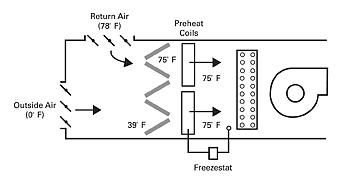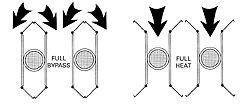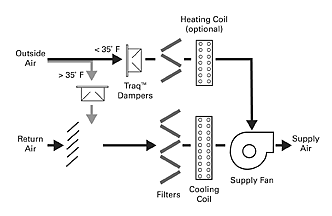
Before ASHRAE (the American Society of Heating, Refrigerating and Air-Conditioning Engineers) Standard 62 was adopted, one of the most popular chilled water coil freeze protection solutions was simply closing off the outside air.
However, ASHRAE Standard 62 significantly increased required outside air ventilation rates. Now, flow-measuring outside air dampers are used to verify compliance with ASHRAE Standard 62. If the outside air dampers are closed during occupied operation, the building automation system (bas) alerts building operators that adequate outside ventilation air is not coming in and that indoor air quality will suffer.
What’s the solution? Keep the fluid in the cooling coil from freezing so that the right amount of outside ventilation air can be brought in at any outside air temperature.
This article presents the latest tried and tested alternatives available to hvac engineers to provide outside ventilation air and avoid freezing the chilled water coils. These solutions have varying costs and effectiveness. Choose the one that is best for your application.

Using Enhanced Mixing Dampers
The standard mixing box generally offers minimal mixing (see Figure 1). Air handler manufacturers can slightly improve the mixing box effectiveness by increasing the air velocity through the dampers. Damper velocities around 1,500 ft/min mix somewhat better than lower velocity dampers. Another option is to reposition the two dampers closer together or to interlace the outside and return air streams.Advantages: Inexpensive. Low pressure drop.
Disadvantages: Mixing dampers have very limited effectiveness when compared with other alternatives. If we assume that a standard mixing box stratifies, or creates freezing air at the cooling coil at an outside air temperature of 26˚F, the enhanced mixing box alternative could work with outside air in the 12˚ to 23˚ range. The exact performance is dependent on the enhanced mixing box design.

Using Air Blenders
Fixed angle “swirl” blenders can be placed just after the mixing box to improve mixing of the outside and return air streams (see Figure 2). The blender uses about 0.2 in. of static pressure to swirl the air and helps mix the outside and return air streams. There are many types of blenders with varying effectiveness.The better ones require the space of one-half the blender’s diameter upstream and of one blender diameter downstream. Typically, blenders allow the outside air to be 25˚ to 40˚ degrees colder before the preheat coils need to be turned on. This option is generally used with outside air designs between 10˚ and 25˚.
Advantages: Does not require maintenance or moving parts. Works effectively and consistently.
Disadvantages: Air blenders need to be designed based on outside and return air damper positions. They increase unit length and have an operating cost penalty but are considered “middle of the road” among the seven options. First cost is typically higher than preheat or enhanced dampers, but less than energy recovery.

Adding Glycol to the Chilled Water
Glycol can be added to the cooling system water to lower the water freezing point. The coil freezestat can be reset downward to reflect the new fluid freezing point.Advantages: Effective, fairly easy to maintain, and always “active.” Offers internal pipe corrosion protection. Works well with variable-air volume systems.
Disadvantages: Glycol is expensive to purchase, resulting in high first cost. Glycol also reduces the density of the water, increasing pumping energy and chiller operating costs and it increases the potential for leaks at pipe joints.
If glycol leaks inside the air handler, it can remove the zinc coating from a galvanized drain pan allowing it to rust. (This can be prevented by using stainless steel coil casings, supports, and drain pans.) The glycol type and the concentration level determine the effective temperature of this option.

Draining the Cooling Coil
Provide drain and vent connections on every coil as well as shutoff valves to isolate the coils from the chillers. In the fall, drain the coils and then use compressed air to remove as much water as possible. Add glycol to prevent any remaining water from freezing. Finally, disconnect the freezestat to prevent nuisance trips.Advantages: Low first cost, no increased energy use, works in any climate. Works well with variable-air volume systems.
Disadvantages: There is a high maintenance cost because the coils must be drained in a timely fashion. In climates with wide swings in outside air temperatures below freezing and into the cooling mode, the coils would have to be drained several times in intermediate seasons. It could even require coils to be drained on a daily basis. This is an added labor expense and there is the risk that it may not get done in a timely manner.
Adding Preheat
Use an outside air or mixed air preheat coil to raise the outside air temperature above freezing before it reaches the cooling coil. Position the freezestat between the preheat and cooling coils. If stacked preheat coils are used, design the preheat coil valves and controls so that each coil is controlled independently (see Figure 3). Independent coil control, as opposed to coil bank control, avoids overheating the air stream as the preheat coil works to protect the cooling coil.Advantages: Very effective. Can be used in any climate, particularly if the preheat coil is located in the outside air stream before the mixing box. In very cold climates, the preheat coil can be placed in the inlet hood of outdoor chilled water air handlers in lieu of the typical moisture eliminator. Works well with variable-air volume systems.
Disadvantages: The operating cost is average compared to all other alternatives. There is risk of freezing the preheat coil. Preheat coil options are listed below:
- Steam coils are very effective and provide a relatively low freeze risk if properly designed and trapped. The best choice is the tube- within-a-tube steam coil that uses steam pressure to blow any condensate back out of the coil. If this type of coil is double trapped, no known failures have occurred. Another option is to use internal face-and-bypass dampers and let the steam coil run wild. This option prevents the coil from freezing, but if the unit is shutdown with the coil wide open, excess heat from the steam coil can damage fan bearings, belts, and insulation. Therefore, limit the fan off-unit temperature.
- Integral face-and-bypass coils (see Figure 4) are designed with bypass areas between the coil tubes and have face-and-bypass dampers on both sides of the coil to provide good temperature control at light heating conditions. The dual dampers open to the fins if heat is needed. If heat is not needed, the dampers close and prevent air from entering or wiping the coil fins. Available in vertical or horizontal configurations, these coils offer very effective steam or hot water preheat.
Using Energy Recovery Preheat
Parallel exhaust air energy recovery options transfer heat from the leaving exhaust air stream to the incoming outside air stream. If enough heat is transferred, the outside air will be above freezing and the cooling coil is therefore protected.
- Coil loops with glycol are about 60% effective and can transfer heat from multiple, nonadjacent exhaust air streams to multiple outside air streams. They are very flexible, though recovery is limited by the energy available in the exhaust air. Recovery must be limited once the exhaust air drops to freezing or ice will form on the exhaust recovery coil.
- Energy wheels transfer heat and humidity from adjacent exhaust air and outside air streams. The typical energy wheel is 70% effective. Wheels transfer sensible and latent heat and typically have a lower freezing point than a coil loop or fixed-plate heat exchanger. However, they can also ice up on the exhaust airside of the wheel. This condition can be avoided by using outside air bypass in some climates or wheel outside air preheat in any climate. Since the wheel preheat is needed only in the very coldest weather, electric preheat is a good choice. It has a low first cost and, because it is very seldom needed, it has a fairly low operating cost. Wheel preheat allows the wheel to operate at the highest possible recovery effectiveness. Blenders may be needed in the unit mixing box if the energy wheel leaving air temperature goes below freezing or outside air bypass is used for wheel freeze protection.
- Air-to-air fixed-plate heat exchangers transfer heat between adjacent exhaust air and outside air streams. The typical plate exchanger is 78% effective. The plate exchanger has a higher freezing point than a coil loop or wheel, but this point can be extended down by using frost avoidance dampers. Another option is to place two plate exchangers in parallel and cycle the outside air between the two exchangers. This option has a high first cost and is typically seen only in very cold climates, such as Canada. Blenders may be needed in the unit mixing box if the plate exchanger outside air leaving air temperature goes below freezing or if outside air bypass freeze protection is used.
Advantages: Air-to-air recovery options generally have the lowest overall energy consumption of the seven options. Recovery significantly increases supply and exhaust fan brake horsepower, but thermal savings more than offset the difference. Air-to-air recovery is now required by ASHRAE Standard 90.1 on all air handlers above 5,000 cu ft/min having more than 70% outside air. These exchangers work well with variable-air volume systems and are effective down to about -20˚.
Disadvantages: They are generally not economically justified if exhaust air quantity is less than 70% of incoming outside air quantity. Also, they have a high first cost.
Using A Winterizer
Winterizer coil protection uses a combination of two air handlers of differing sizes to create a separate outside air introduction path into the fan section whenever the outside air is below 35˚ and the fan is on (see Figure 5). The winter outside air path should have filters and a heating coil. Introducing the outside air into the fan section should be done in a manner that does not condense water out of the return air stream. This section should operate only when the supply fan is on.Advantages: Winterizer units works with any outside air temperature and return air temperature/humidity conditions. They add no additional static pressure to the supply fan and it is easy to understand their operation. They require less length than the blender or energy recovery and work well with variable-air volume systems.
Disadvantages: Winterizer units increase air handler control and piping cost. The cost of the second small outside air unit is typically higher than the blender, but less than energy recovery. ES
